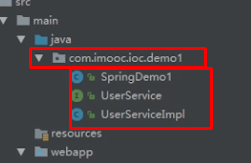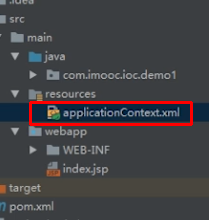Spring从入门到进阶–Spring入门
第1章 Spring 介绍
1-1. Spring的概述
- 1、Spring是什么
一个轻量级的开源框架,可以使我们的开发变得简单,是一个一站式的框架。
-** 2、Spring的优点有哪些?**
1.方便解耦,简化开发
2.AOP编程的支持
3.声明式事务的支持
4.方便程序的测试
5.方便继承各种优秀框架
6.降低JavaEE API的使用难度

- 3、Spring的模块有哪些?
Spring核心包:
1.Beans
2.Core
3.Context
4.SpEl
完整的模块架构图,请看下面的图
1-2. Spring的IOC的底层实现原理
Spring的IOC底层原理实现
-
传统方式的开发:
UserService us = new UserService();
在Web层直接创建一个业务层的对象
缺陷:没有面向接口编程 -
改进:通过面向接口编程
UserService us = new UserServiceImpl();
在Web层通过业务层的接口创建了实现类
缺点:Web层与业务层产生了耦合,不符合OCP原则(修改关闭,扩展开放) -
改进:使用工厂模式
由原来直接用接口创建实现类 改为 通过用工厂来创建实现类
工厂类代码:
class FactoryBean{
public UserService getUs() {
return new UserServiceImpl();
}
…
}
耦合关系变为:接口和工厂类耦合
获得对象实例:UserService us = FactoryBean.getUs();
如果需要切换底层实现,虽然不用改获得实例的代码但是需要改工厂类的代码。
!!!那有没有一种方法可以不需要修改任何的源代码呢?
-
方案:使用工厂+反射+配置文件(xml)(可以完成程序的解耦合)
<bean id=“us” class:“com.imooc.UserServiceImpl”/>class FactoryBean{
public static Object getBean(String id) {
…
反射
}
}
原理:在工厂类中通过解析xml文件的标签,根据传入的id去创建对应类型的对象。


第2章 Spring IOC 快速入门
2-1. 开发步骤
下载Spring的开发包
https://repo.spring.io/libs-release-local/org/springframework/spring/
目录结构:
docs : API文档和开发规范
libs : 开发需要的jar包、源代码和文档
schema : 开发需要的xml文档的约束
复制Spring开发jar包到工程
理解IOC控制反转和DI依赖注入
编写Spring核心配置文件
在程序中读取Spring配置文件,通过Spring框架获得Bean,完成相应操作
2-2 引入jar包


2-3 代码实现



- UserService.java
package com.imooc.ioc.demo1;
/**
* Created by jt on 2017/10/8.
*/
public interface UserService {
public void sayHello();
}
- UserServiceImpl.java
package com.imooc.ioc.demo1;
/**
* Created by jt on 2017/10/8.
*/
public class UserServiceImpl implements UserService{
public void sayHello() {
System.out.println("Hello Spring" );
}
}
- 添加配置文件



<?xml version="1.0" encoding="UTF-8"?>
<beans xmlns="http://www.springframework.org/schema/beans"
xmlns:p="http://www.springframework.org/schema/p"
xmlns:xsi="http://www.w3.org/2001/XMLSchema-instance"
xsi:schemaLocation="http://www.springframework.org/schema/beans http://www.springframework.org/schema/beans/spring-beans.xsd">
<!-- UserService的创建权交给了Spring -->
<bean id="userService" class="com.imooc.ioc.demo1.UserServiceImpl">
<property name="name" value="李四"/>
</bean>
</beans>
- Test: SpringDemo1.java
-
- UserServiceImpl.java

public class SpringDemo1 {
@Test
/**
* 传统方式开发
*/
public void demo1(){
//接口中没有get/set方法
// UserService userService = new UserServiceImpl();
UserServiceImpl userService = new UserServiceImpl();
// 设置属性:
userService.setName("张三");
userService.sayHello();
}
@Test
/*
Spring的方式实现
*/
public void demo2(){
//创建Spring的工厂
ApplicationContext applicationContext=new ClassPathXmlApplicationContext("applicationContext.xml");
//通过工厂获得类:
UserService userService=(UserService) applicationContext.getBean("userService");
userService.sayHello();
}
}
第3章 概念总结
3-1 IOC和DI的概念
Spring的两个概念:
- IOC Inverse of Control反转控制的概念,就是将原本在程序中手动创建UserService对象的控制权,交由Spring框架管理
简单说,就是创建UserService对象控制权被反转到了Spring框架 - DI Dependency Injection 依赖注入的概念,就是在Spring创建这个对象的过程中,将这个对象所依赖的属性注入进去。依赖注入的目的是在代码之外管理程序间组件的依赖关系;依赖注入减低了程序组件间的耦合。 (先有IOC才有DI)

package com.imooc.ioc.demo1;
/**
* Created by jt on 2017/10/8.
*/
public class UserServiceImpl implements UserService{
// 添加属性:
private String name;
public void sayHello() {
System.out.println("Hello Spring" + name);
}
public String getName() {
return name;
}
public void setName(String name) {
this.name = name;
}
}


来源:CSDN
作者:紫蝶侠
链接:https://blog.csdn.net/yangshengwei230612/article/details/104107140














